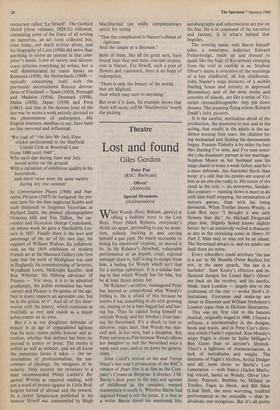Arts
Companion of Honour
John McEwen
-1- am of mind to go blackberrying which it is a pity to do alone One should always have companions for fruit-picking:-
So choose them carefully, there are the living to choose from, Or you can choose from the dead' Thus Sacheverell Sitwell, whose aesthetic blackberrying over the past 60 years was rewarded with a CH in the New Year's Honours, surely the most deserved (if over- due) and appropriate award imaginable (with the possible exception of Sir Steven Runciman's in the same list) and one that must gladden the heart and strengthen the resolve of all who believe, at the outset of this ill-omened year, that beauty will save the world.
It is sad that the word 'dilettante' from the Latin delectare = to delight, hence 'a lover of painting or music' or 'a lover of the fine arts; originally, one who cultivates them for the love of them rather than professionally' (OED) — has come to mean 'amateur', itself shorn of all Corin- thian Casual associations of excellence; because it is the spirit of dilettantism that has been most remorselessly attacked by the depreciation of the word, and it is that spirit above all that has been sustained by the tireless writing of Sacheverell Sitwell. Against the drive to uniformity and its con- comitant destruction and ugliness — caused by the narrowness of the PhD academic as much as the brute hatred of the local plan- ner — he has erected a bastion of no fewer than 200 separate publications of poetry and prose in the cause of enlightenment and the defence of beauty, both natural and man made, throughout the world. His un- prejudiced response has not only transformed taste, it has saved some aspects of this beauty from extinction.
No one, even subconsciously, can have escaped his beneficial influence. It is thanks to him, as much as anyone, that 20th- century ears and eyes have been opened to the music, art and architecture of the Bar- oque and Rococo — not simply through the impact of his first and still most famous book, Southern Baroque Art, published in 1924 when he was 26, but also of one on Spanish Baroque alone, published the same year, and of another in 1927 on Austrian and southern German Baroque and Rococo. Scarlatti and El Greco remain the most prominent beneficiaries of this in- terest, and to this day in the Sicilian town of Noto there remains the legacy of a restaurant called 'Le Sitwell'. The Gothick North (three volumes, 1929-31) followed, containing some of the finest of all writing on tapestries, an art form collected but, even today, not much written about, and his biography of Lizst (1936) did more than anything to revive an interest in that com- poser's music. Love of variety and idiosyn- crasy informs everything he writes, but is well demonstrated by travel books on Romania (1938), the Netherlands (1948) typically concerning itself with the previously unconsidered Rococo decora- tions of Friesland — Spain (1950), Portugal and Madeira (1954), Denmark (1956), Malta (1958), Japan (1959) and Peru (1961); and that in the darkest hour of the last war he wrote a work entirely devoted to the phenomenon of poltergeists. His English interests, needless to say, have been no less personal and influential.
'We read of "the late Mr Jack Elms cricket professional to the Sheffield United Club at Bramhall Lane From 1880 until 1940", Who each day during June and July would arrive on the ground With a carnation of exhibition quality in his buttonhole, and never twice wore the same variety during any one summer'.
In Conversation Pieces (1936) and Nar- rative Pictures (1937) he instigated the pre- sent taste for the then neglected Stubbs and such dismissed or forgotten Victorians as Richard Dadd, the pioneer photographers Octavius Hill and Fox Talbot, the car- toonist and illustrator George Cruikshank, on whose work he gave a Northcliffe Lec- ture in 1937. Finally there is the love and patronage of the art of his own day: his support of William Walton; his collabora- tion on the 1919 exhibition of modern French art at the Mansard Gallery (the first time that the work of Modigliani was seen in England); his commissioning of Severini, Wyndham Lewis, McKnight Kauffer, and Rex Whistler; his lifelong advocacy of Picasso — 'For once, it is to be admitted grudgingly, the public estimation has been correct and Picasso is the genius of the age. Not in many respects an agreeable one, but he is the genius of it'. And all of this inter- woven with the poetry, which continues as fruitfully as ever and stands as a major achievement on its own.
But it is as our doughtiest defender of beauty in an age of unparalleled ugliness that he most claims public honour and at- tention, whether that defence has been ex- pressed in poetry or prose. The enemy is within as well as without, and we all know the cancerous forms it takes — the ter- ritorialness of professionalism, the nar- rowness of ideology, the smugness of in- sularity. Only recently the reviewers to a man recommended Philip Larkin's Re- quired Writing as required reading, with not a word of protest against its Little Brid- lington hatred of abroad and the present. In a recent Symposium published in his honour Sitwell was commended by Hugh
MacDiarmid (an oddly complementary spirit) for seeing `That the complicated is Nature's climax of rightness And the simple at a discount.'
Both of them, like all the great men, have found their first and most constant inspira- tion in Nature. For Sitwell, such a poet of flowers and transience, there is no hope of redemption, 'There is only the beauty of the world, Not yet blighted, And which may turn to anything.'
But even if it does, his example shows that there will surely still be 'blackberries' worth the picking.



































 Previous page
Previous page